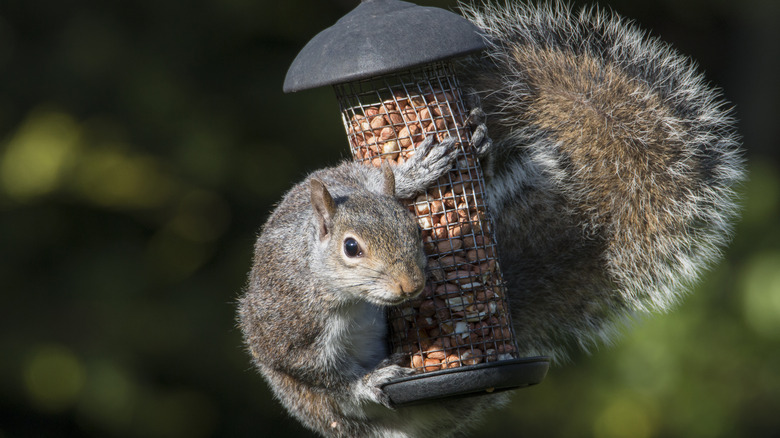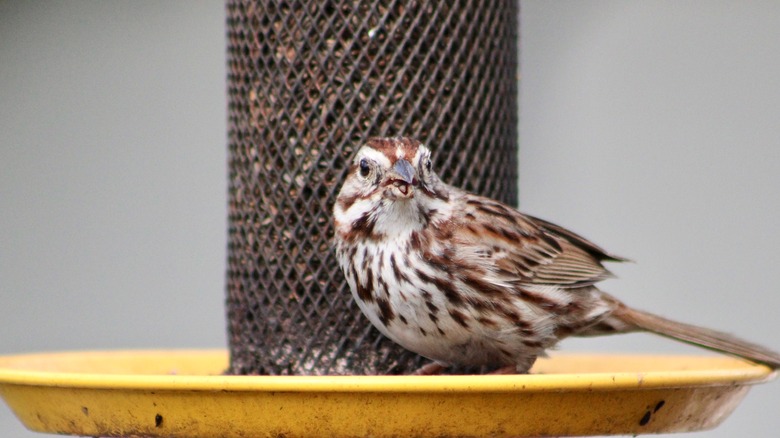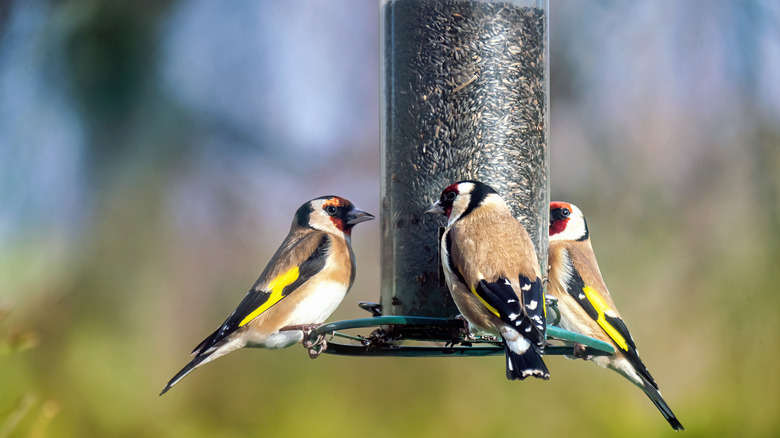Deter Squirrels From Your Bird Feeder With The Treat Birds Go Nuts For
You might have set up a bird feeder in your backyard to attract local birds to your garden, but does it lure more than just feathered friends? Bird feeders can also bring all the neighborhood squirrels to your property. The squirrels see it as a free meal ticket, and they'll often jump onto the feeder and raid it before any birds can get to it. This poses a problem for several reasons. First, they can scatter seeds and nuts on the grass below while eating, which can attract worrisome pests such as mice and rats. Second, their weight can damage the feeder, forcing you to buy a new one. And lastly, it leaves little seed left over for birds, which is the whole point of hanging it in the first place! To keep squirrels out of your bird feeder, you can swap the feed for something that birds love but squirrels hate. One such option is Nyjer seed.
Nyjer seed, or Nyjer thistle, is harvested from the African yellow daisy and is mainly eaten by finches, sparrows, chickadees, and mourning doves, among others. It will basically attract any small bird with a sharp, pointed beak. They need such beaks to break open the shell and eat the seed inside, which is also why squirrels tend to avoid them. Here is everything you need to know about how to deter these furry pests and keep your feeder squirrel-free.
Why this works
Nyjer seed is a great repellent because squirrels aren't very interested in it as a snack, which means they won't go sniffing around your feeder. While the seed is high in oils that help birds store energy and feel sufficiently full, it doesn't contain the kind of fats that squirrels find tasty. Plus, the seed isn't easy to get to thanks to its shell, which makes the snack more bother than it's worth for these furry pests. Because of that, they're likely to avoid the feeder and go scavenge for food elsewhere. However, keep in mind this doesn't mean you'll never see a curious squirrel on your feeder. They might sniff around it if they're incredibly hungry — or just inquisitive — but making the switch should help a great deal.
You might also need to upgrade your feeder to hold these seeds. Since they're small and skinny, having too large of a feeding hole can mean they will easily spill out. Choosing one that's made with a mesh sock or has a small hole is best.
Caveats to keep in mind
There are a few caveats to keep in mind when filling your bird feeder with this particular seed. First, since it is thin, long, and has a fine shell, it has a tendency to go stale. That means you need to keep an eye on your feeder and swap the seeds the moment you see them go bad. If you don't, you risk birds avoiding your backyard. That's because most birds are rather picky eaters, and they would rather eat fresh seeds than forage for old fare. Luckily, it won't dry out until a couple of months, so you won't have to swap it out too frequently.
If you're unsure whether or not your stash is stale, an easy way to figure it out is to crush a handful of seeds on a paper towel. If oily splotches are left behind, they're still fresh. You can also eyeball them — if they look shiny, they're likely still fresh. If the shells have a dull tinge, they have since dried out. Second, these seeds are most attractive to birds during fall and winter since the oil packs a punch of energy they need during those leaner seasons. As a result, you might not see as many birds attracted to your feeder during the summer months.


